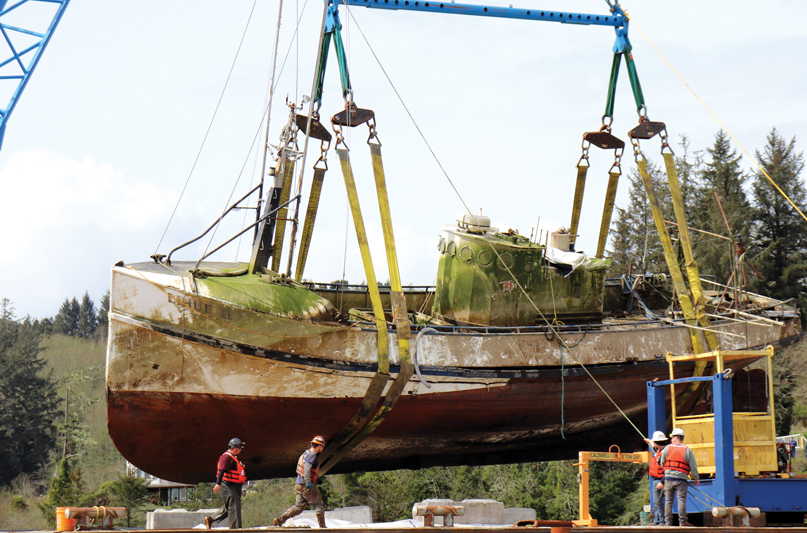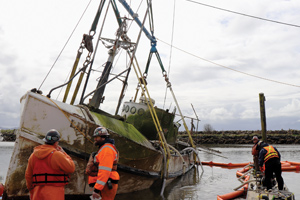
The Port of Ilwaco at the tip of southwest Washington is the center of sportfishing on the lower Columbia River when the famous “Buoy 10” season gets going on August 1. Hundreds of boats and thousands of fishing enthusiasts will arrive at the harbor hoping for an exciting day on the water and a salmon in the cooler. But unless you are the lucky person who actually lands one, this hardly compares to the day last April when the harbor was taken over by dozens of officials and a salvage team who arrived by truck, work boat, and barge to help remove a derelict 61’ wooden fishing boat from the marina.
Built in 1939 and proudly named after the county seat of Kauai County, the Lihue II had been a successful offshore tuna troller for Hawaiian Tuna Packers, which became part of Bumble Bee Seafoods after WWII. That connection may be why the boat ended up on the Columbia when it was well past its prime. It had become a fixture and an eyesore around the mouth of the river in recent years—until it was abandoned by an anonymous owner last year in Ilwaco in mid-November. He must have suspected something was amiss below the waterline, because his 79-year old boat sank a few days later during a gale on the night of November 18. Fast action by port employees, the Coast Guard, and environmental agencies kept the boat from spilling a tankful of diesel.
The port’s crew placed an oil boom around the wreck site to keep pollution from spreading. Then a team of commercial divers went to work to plug vents and likely leaks, and a contractor pumped the remaining fuel out. It took months to trace the boat’s ownership and insurance—or lack of it—and come up with the funding to remove it safely. Port Manager Guy Glenn Jr. still had to figure out what to do with it before the busy charter sportfishing season picked up. “We’ve been dealing with other derelict vessels for years,” he commented, “but
never one of this size,”
Washington State’s derelict vessel program has enough funding to deal with a few small boats per year and only if they are deemed a serious environmental and marine hazard. It was spring before all the details were ironed out, then the nasty weather earlier in April forced the contractor Global Diving and Salvage of Seattle to postpone the operation a couple of times. By the time the weather cleared, the crane barge they had chartered was almost out of time before it had to move on to another job.

Finally, the big day arrived, and salvage master Kris Lindberg stood on the dock in his hardhat, directing a small fleet of boats and equipment manned by the experienced salvage team from Global. The recovery began with a diver working at low tide in the mud to thread heavy yellow slings underneath the Lihue II. The lines were connected to heavy hooks dangling from the crane mounted on a barge supplied by Portland, Oregon based Advanced American Construction. The boom towered over all the masts in the port as the steel cables took the strain of the Lihue II; its rusty iron keel, 300-horsepower engine, and all the water inside the hull.
Once the deck came clear of the murky water, the workers sprang into action and began inserting hoses into the hull. They fired up the row of motorized pumps on the dock, which began to remove hundreds of gallons of dirty bilge water. As the boat’s weight decreased, the crane operator began to hoist it until the entire boat came clear of the water. Traces of old white paint showed through the mud and slime, with no guarantee that the planking and frames could withstand the short move to the deck-cargo barge at the end of the dock. The crane slowly rotated to back the boat out of its slip, then the water-logged wreck flew through the air and was deposited on the barge without a mishap.
On shore in the port’s boatyard, the demolition paused when a small amount of asbestos was found around the boat’s exhaust, which raised the cost of disposal by several thousand dollars. Once that was removed, the crew removed steel and other metal components for recycling; the hull was crushed by an excavator and hauled to the county landfill. That was the last voyage of the Lihue II, which ironically means “cold chill” in Hawaiian. This operation cost about $188,000, with the state derelictvessel program paying about 90 percent of the cost, leaving the Port to come up with $20,000.
When it comes to derelicts, prevention is easier than disposal, as the oyster growers of Willapa Bay, the next inlet up the coast, are still learning. That’s where the former Antarctic research ship Hero is still slowly disintegrating at the dock, a situation I covered in the October, 2017 issue of NWY, which you can read online at nwyachting.com.